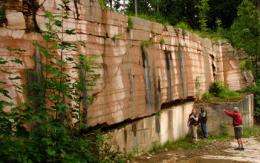Earth's past is warning for the future

When the Earth’s carbon dioxide level increased at a rapid rate during the Triassic-Jurassic period 200 million years ago, nearly half the ocean’s marine life became extinct. USC Dornsife geologists contributed to a recent paper that examines materials embedded in ancient rocks to provide clues about the possibility of similar future global events.
The study published in the March 2 issue of Science indicates that ocean acidification may have been the cause of extinction events in the past, and warns of future extinctions because an even more severe acidification event is happening today.
USC Dornsife alumna Sarah Greene, who earned a Ph.D. in geological studies in 2011, and Rowan Martindale, a doctoral candidate in earth sciences, joined scientists from 18 institutions worldwide in researching geological records. The evidence suggests what the future holds if atmospheric human-induced carbon dioxide levels continue to increase.
Greene and Martindale along with 19 other scientists report that examining the fossil records of ancient acidification events may provide scholars with evidence to predict and plan for future global changes. Bärbel Hönisch of Columbia University was the paper’s lead researcher.
Martindale and Greene have scoured ancient rock beds in Austria, England, British Colombia and Nevada for evidence of acidification.
“The Triassic-Jurassic event tells us that carbon dioxide increase coupled with a hypothesized acidification event caused a mass extinction,” Martindale said. “That may tell us what organisms will die or survive in the near future and how long it will take for things to recover, if they do recover.”
The study discusses how carbon dioxide emissions affect marine life. When gases are emitted, carbon dioxide in the atmosphere is absorbed into Earth’s oceans. When carbon dioxide and water bind together to create carbonic acid, the ocean becomes more acidic and water pH levels decrease; an event known as ocean acidification. The average ocean pH has decreased from 8.2 to 8.1 since the late 18th century industrial revolution and may decrease by additional 0.2 to 0.3 pH units by the end of this century, Martindale said.
David Bottjer, chair of USC Dornsife’s Department of Earth Sciences and professor of earth sciences and biological sciences, ignited Martindale’s interest in the Triassic-Jurassic period during her first year at USC by recommending she combine her interest in reef ecosystems with mass extinctions. Since 2007, she has researched evidence of elevated atmospheric carbon dioxide levels to determine the chemistry behind ocean acidification in order to understand effects on ecosystems.
“The contribution made by Rowan and Sarah to this paper is crucial to the study’s success,” Bottjer said, “particularly in the analysis of the possibility that the end-Triassic mass extinction was an ocean acidification event."
The geological record during the Triassic-Jurassic event provides scientists a strong indication that an ocean acidification event occurred. When the supercontinent Pangaea began to split apart into the continents that we know today, there was strong volcanic activity (volcanoes from Newfoundland to Morocco); these volcanoes caused atmospheric carbon dioxide levels to increase and the ocean’s pH level decreased.
Carbonic acids in the ocean can dissolve the shells of oysters and clams and also wreak havoc on marine life such as coral reefs. Lower pH levels also adversely affect nitrogen levels, which marine life rely on to survive, Martindale said.
Greene said the geological record parallels some important aspects of anthropogenic climate change — or the production of greenhouse gases emitted by human activity.
“We can look at the outcomes of these paleo-events to inform our predictions for the future,” Greene said. “The rate at which carbon dioxide is released to the atmosphere is critical in determining the severity of ocean chemistry change that will result — and the faster the carbon dioxide release the worse it gets.”
Although similarities exist, no past event perfectly parallels future projections in terms of disrupting the balance of ocean carbonate chemistry, Martindale noted.
“We want scientists and governments to look at these past events and learn from them,” Martindale said. “We see intervals in the rock record when pH dropped and those events led to extinctions of marine organisms. That result is really powerful because we’re showing it happened before and could happen again.”
Provided by USC College

















